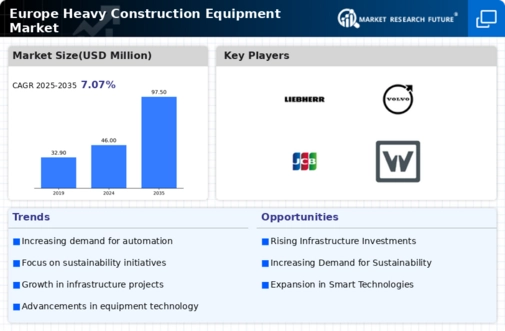Market Trends
Key Emerging Trends in the Heavy Construction Equipment Market
The Europe Heavy Construction Equipment Market is a dynamic and competitive landscape, with various players employing diverse market share positioning strategies to gain a competitive edge. One prevalent strategy involves differentiation based on product innovation. Companies strive to develop cutting-edge equipment with advanced features, enhanced performance, and improved sustainability. By constantly innovating, companies aim to capture market share by offering solutions that meet the evolving needs of construction professionals.
Another significant market share positioning strategy revolves around cost leadership. Some companies focus on achieving economies of scale, optimizing production processes, and leveraging efficient supply chain management to reduce costs. This allows them to offer competitive pricing to customers, attracting a broader segment of the market. Cost leadership can be particularly effective in price-sensitive markets where buyers prioritize affordability without compromising on quality.
Furthermore, strategic partnerships and collaborations play a pivotal role in market share positioning within the Europe Heavy Construction Equipment Market. Companies often form alliances with suppliers, distributors, or other industry players to strengthen their market presence. Such collaborations enable them to access new markets, leverage complementary strengths, and jointly develop innovative solutions. These partnerships not only enhance product offerings but also contribute to a broader market reach.
In addition to product and cost-related strategies, a focus on customer experience and brand positioning is crucial for gaining market share. Building a strong brand image through effective marketing, customer service, and after-sales support can differentiate a company from its competitors. Positive customer experiences and a reputable brand contribute to customer loyalty, leading to repeat business and positive word-of-mouth referrals, ultimately expanding the market share.
Market segmentation is another essential aspect of market share positioning in the heavy construction equipment sector. Recognizing diverse customer needs and tailoring products and services to specific segments can be a successful strategy. Whether targeting large-scale infrastructure projects or catering to the needs of smaller construction businesses, companies can optimize their market share by understanding and addressing the unique requirements of different customer groups.
Moreover, the adoption of sustainable practices and the development of eco-friendly construction equipment have become integral to market share positioning. As environmental consciousness grows, customers increasingly prefer equipment that reduces environmental impact and promotes sustainability. Companies that align their offerings with these values not only meet regulatory requirements but also appeal to a growing segment of environmentally conscious buyers, thereby expanding their market share.
Lastly, continuous monitoring of market trends, technological advancements, and regulatory changes is crucial for effective market share positioning. Companies that stay agile and responsive to market dynamics can quickly adapt their strategies to seize emerging opportunities or address potential challenges. Proactive engagement with market shifts ensures that companies remain relevant and competitive, enabling them to secure and grow their market share in the dynamic landscape of the Europe Heavy Construction Equipment Market. In conclusion, a combination of innovation, cost leadership, strategic partnerships, brand positioning, market segmentation, sustainability, and adaptability are key elements in the market share positioning strategies pursued by companies operating in the Europe Heavy Construction Equipment Market.







Leave a Comment